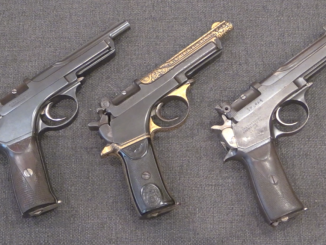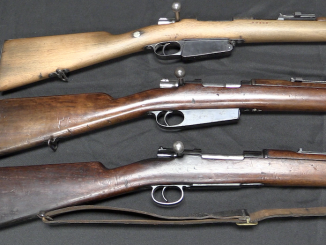Star introduced the Model A as the commercial sale version of the Model 1920 and 1921 pistols which they had entered into Spanish military trials in 1920. The pistol was rejected by the Army in favor of the Astra 400, but the Spanish Guardia Civil adopted it as their standard sidearm. The original design included a grip safety which was quickly removed, and in 1921 the Model A was added to Star’s sales catalog.
The blossoming civil war in China was creating a significant demand for automatic pistols by the late 1920s, especially ones with shoulder stocks and large magazines. The Mauser C96 was proving exceptionally popular, and Star attempted to gain a foothold in that market with a carbine variant of their Model A. This version included an extended barrel, wooden combination holster and stock, and optional 16- and 32-round magazines. It was chambered for the 7.63mm Mauser cartridge, instead of the 9mm Largo used by the domestic Spanish market.
The Star failed to sell well, however, being far less popular that the C96 and its lookalikes (such as the Astra Model 900 series). Even a select-fire version of the Star failed to drive significant sales, and the gun was discontinued in 1928




Given that the 1911 has a considerably stronger action than the c96, could you safely fire 7.62×25mm Tokarev ammo through the model A?
“7.62×25mm Tokarev”
I must ask: which cartridge exactly?
Original Soviet version (model of 1930) has 1860-2070 kg/cm^2 pressure and muzzle velocity 420-450m/s from TT with 5,45-5,60g bullet. П-45 powder was used.
(data from Альбом конструкций патронов стрелкового оружия)
Interestingly, that is lower than the C.I.P. limit for 7.63mm Mauser, which is 2250 bars (2290 kgf/cm²; 32,600 PSI). The limit for 7.62×25 Tokarev is 2500 bars (2550 kgf/cm²; 36,300 PSI). Of course the old Soviet number was not measured using a modern pressure transducer confirming to C.I.P. specs, so the pressures can’t be compared directly. Still, the C.I.P. spec is probably based on some later loading of the 7.62mm Tokarev.
This might be caused by fact of Mauser Broomhandle being still in usage.
Other reason might be one of competitors of Tokarev 1930:
Пистолет Прилуцкого обр. 1930 года
http://www.barrels-n-bullets.ru/index.php/pistols/russia/prilutsckogo1930
delayed blow-back design, derived from experimental blow-back Пистолет Прилуцкого обр. 1914 года, which was considered worth of further development by Main Artillery Directorate, but with outbreak with First World War it was impossible
Photos of Пистолет Прилуцкого обр. 1914 года
http://www.barrels-n-bullets.ru/index.php/pistols/russia/prilutsckogo1914
notice that magazine release is part of magazine rather than pistol, it needed further refinement (it throws spent cases directly into user face, has complicated field stripping method and magazine change was hard)
I don’t know, but it is best not to try it unless you are certain that the slide won’t snap in half. Plus, the M1911’s barrel link may also be the potential weak spot. Abuse it and the gun will likely jam when the link breaks!
Did I mess up?
About 20 years ago, a batch of Lend-Lease 1911A1s came in from Red China that had been converted to 7.62 x 25mm. Apparently, the Colt-Browning action can handle quite a bit of stress.
Of course, considering that it has in the past been chambered by Colt themselves for such pressure-emphatic loads as the .38 Super Colt Auto and the 10mm Auto, this shouldn’t really surprise anybody.
The weak point in the 1911 breeching, pressure-wise, is the lower arc of the area just above the cartridge case-head. Due to the feed ramp in the chamber, this area is unsupported during firing. If you’re going to get a case-head separation or rupture due to pressure, this is where it generally starts.
Note that the Russian/etc. Tokarev Model 30/33 pistol, also based on the 1911 locking system, has a very similar chamber geometry and was designed from the outset for 7.62 x 25mm.
cheers
eon
“based on the 1911 locking system”
There exist GRIZZLY automatic pistol, using that system:
http://modernfirearms.net/handguns/hg/usa/lar-grizzly-e.html
chambered for .45 Winchester Magnum, not weak hand-gun cartridge by any means.
It seems that main problem with that design was service life of return springs.
Hmmm, is that a left-handed holster stock? Seems so.
I doubt it. Most users were right-handed, so it would make very little sense to create a left-handed holster. If the pistol is right-handed, the stock must also be right-handed. The stock holsters for the Luger and the Mauser C96 were attached in the same manner and both of those pistols were right-handed!
Looking at this gun enforces my view of Spanish (or Basque for that matter) pistols and revolvers as benchmark of quality and practicality. I do not think that lack of grip safety took anything away.
“Spanish”
There was multiple automatic pistol produced in Spain in inter-war period, varying in quality and creativity.
I might accept statement that 1930s STAR automatic pistol are of good quality but would be very careful about such statement for Spain as whole.
is: “(…)1930s(…)”
should be: “(…)inter-war(…)”